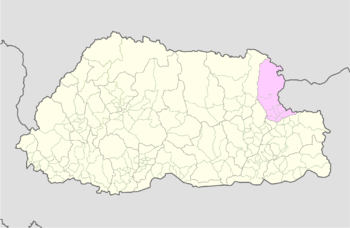Trashiyangtse District
Trashiyangtse District (Dzongkha: བཀྲ་ཤིས་གཡང་རྩེ་རྫོང་ཁག་; Wylie: Bkra-shis Gyang-tse rdzong-khag) is one of the twenty dzongkhags (districts) comprising Bhutan. It was created in 1992 when Trashiyangtse district was split off from Trashigang District. Trashiyangtse covers an area of 1,437.9 square kilometres (555.2 sq mi). At an elevation of 1750–1880 m, Trashi yangtse dzongkhag is rich of culture filled with sacred places blessed by Guru Rimpoche and dwelled by Yangtseps, Tshanglas, Bramis from Tawang, Khengpas from Zhemgang and Kurtoeps from Lhuentse.
Trashiyangtse district བཀྲ་ཤིས་གཡང་རྩེ་རྫོང་ཁག་ | |
|---|---|
District | |
 Map of Trashiyangtse District in Bhutan | |
| Country | Bhutan |
| Headquarters | Yangtse |
| Area | |
| • Total | 1,438 km2 (555 sq mi) |
| Population (2017) | |
| • Total | 17,300 |
| • Density | 12/km2 (31/sq mi) |
| Time zone | UTC+6 (BTT) |
| HDI (2017) | 0.619[1] medium · 6th |
| Website | www |
Trashiyangtse was named by Terton Pema Lingpa during his visit in 15th century meaning; (the fortress of the auspicious fortune).
The northern part of Trashiyangtse encompasses the skills of woodturning and paper making(dzongkha: དལ་ཤོག). Southern part mainly depends on cash crops and animals.
The district seat is Trashiyangtse.
Languages
Three major languages are spoken in Trashiyangtse. In the north, including Bumdeling inhabitants speak Dzala. In the south, Tshangla (Sharchopkha), the lingua franca of eastern Bhutan, is spoken in Jamkhar, Khamdang, Yalang and Ramjar Gewogs. In Tomzhangtshen Gewog, residents speak Chocha Ngacha and khengkha.
Administrative divisions
Trashiyangste District is divided into eight village blocks (or gewogs):[2]
- Bumdeling Gewog
- Jamkhar Gewog
- Khamdang Gewog
- Ramjar Gewog
- Toetsho Gewog
- Tomzhangtshen Gewog
- Trashiyangtse Gewog
- Yalang Gewog
Protected areas
Trashiyangtse District contains Kholong Chu Wildlife Sanctuary, established in 1993, itself part of the larger Bumdeling Wildlife Sanctuary. Bumdeling Wildlife Sanctuary currently covers the northern half of Trashiyangtse (the gewogs of Bumdeling and Yangste), as well as substantial portions of neighboring districts.[3]
See also
References
- "Sub-national HDI - Area Database - Global Data Lab". hdi.globaldatalab.org. Retrieved 2018-09-13.
- "Chiwogs in Trashiyangtse" (PDF). Election Commission, Government of Bhutan. 2011. Archived from the original (PDF) on 2011-10-02. Retrieved 2011-07-28.
- "Parks of Bhutan". Bhutan Trust Fund for Environmental Conservation online. Bhutan Trust Fund. Archived from the original on 2011-07-02. Retrieved 2011-03-26.
External links
- Trashiyangtse dzongkhag administration website